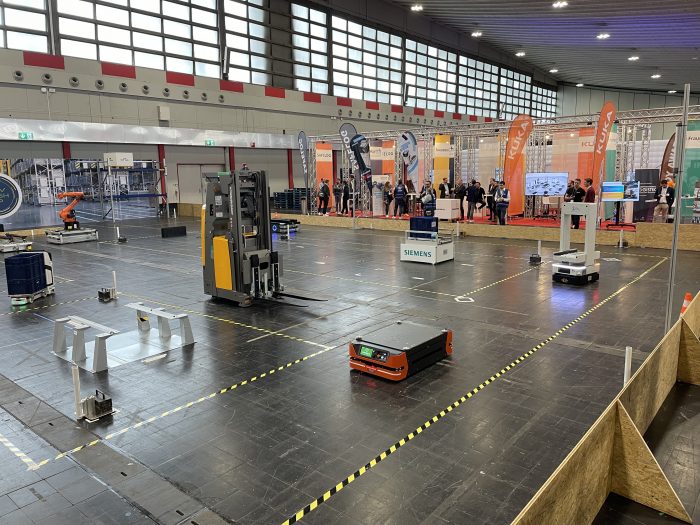Like an Organism – When Transport Robots Make Their Own Decisions

Drive, turn, send light signals—modern logistics relies on central control systems to direct mobile transport robots, assigning them routes and tasks. However, implementing such a control center can be costly, with drawbacks including inflexibility and susceptibility to failures. In contrast, decentralized control systems offer a cost-effective and adaptable alternative, ensuring a stable overall system.
The Role of Centralized Control in Logistics
Automated processes are now well-established in modern production and intralogistics, optimizing internal workflows for greater efficiency. The central control system is the heart of an Automated Guided Vehicle (AGV) system, directing mobile transport robots (MTRs) by assigning transport orders, managing traffic flow, and regulating interactions at intersections. These robots follow commands from a control center, which communicates via Wi-Fi with the transport robots and peripheral systems, such as fire doors, conveyor systems, and handover stations.
Despite its advantages, centralized control has its limitations. System failures, maintenance downtimes, or network disruptions can halt entire fleets. Managing multiple robots increases the burden on the control system, requiring high-performance IT infrastructure and significant investment in hardware, software licenses, and personnel. For small and medium-sized enterprises, these costs can be prohibitive.
Decentralized, Agent-Based Control for Greater Efficiency
Unlike a central control system, agent-based transport robots communicate with each other through intelligent multi-agent systems. They exchange status updates on their position and speed, sharing essential data on routes, environmental conditions, and operational rules. Based on this information, the robots autonomously decide their actions.
SAFELOG GmbH’s CEO, Michael Reicheicher, compares this system to an organism within a society—each robot follows established rules but acts independently. This swarm intelligence allows for dynamic route planning, self-regulated traffic management, and seamless integration with peripheral systems, such as elevators, which communicate their availability and location.
One key advantage of this decentralized approach is its resilience. Even if part of the communication network fails, the swarm continues functioning without major disruptions. Each robot operates independently for extended periods, ensuring system stability even in the event of individual failures.
Expanding the Possibilities of Decentralized Control
Centralized control remains useful for managing vehicles with low computing power or coordinating mixed fleets of robots from different manufacturers, particularly when interoperability via the VDA 5050 interface is required. However, decentralized systems shine when quick process changes are needed.
Swarm intelligence allows updates to be rolled out incrementally without system shutdowns. Small-scale tests can be conducted with one or two robots before full implementation. Unlike traditional control systems, which require maintenance windows for updates, decentralized systems introduce changes seamlessly, reducing risk and operational disruptions.
The biggest advantage of decentralized control is cost efficiency. Without the need for a central control center, automation becomes accessible even to small companies. Whether operating a handful of robots or a fleet of hundreds, businesses can scale their operations flexibly without large infrastructure investments. Hybrid approaches are also possible—centralized and decentralized systems can be combined, allowing swarms to integrate with existing control structures when necessary.
By shifting toward decentralized intelligence, companies can enhance efficiency, reduce costs, and increase system resilience—paving the way for a smarter, more autonomous future in logistics.
For more information, please visit: https://www.safelog.de/news/#n_news
News Categories
- » NEWS HOME
- » Automation & Robotics
- » Industry 4.0
- » Material Handling
- » Sensors
- » Quality & Testing
- » Machine Vision
- » Laser & Optics
- » Metalworking
- » Motion Control & Drives
- » Hydraulics & Pneumatics
- » Process Industry
- » Renewable Energy
- » Agriculture
- » Home & Office Furniture
- » Additive Manufacturing
- » Environmental Tech



